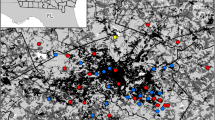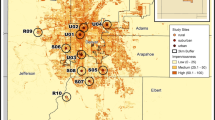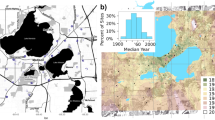Abstract
As cities expand, conservation of beneficial insects is essential to maintaining robust urban ecosystem services such as pollination. Urban warming alters insect physiology, fitness, and abundance, but the effect of urban warming on pollinator communities has not been investigated. We sampled bees at 18 sites encompassing an urban warming mosaic within Raleigh, NC, USA. We quantified habitat variables at all sites by measuring air temperature, percent impervious surface (on local and landscape scales), floral density, and floral diversity. We tested the hypothesis that urban bee community structure depends on temperature. We also conducted model selection to determine whether temperature was among the most important predictors of urban bee community structure. Finally, we asked whether bee responses to temperature or impervious surface depended on bee functional traits. Bee abundance declined by about 41% per °C urban warming, and temperature was among the best predictors of bee abundance and community composition. Local impervious surface and floral density were also important predictors of bee abundance, although only large bees appeared to benefit from high floral density. Bee species richness increased with floral density regardless of bee size, and bee responses to urban habitat variables were independent of other life-history traits. Although we document benefits of high floral density, simply adding flowers to otherwise hot, impervious sites is unlikely to restore the entire urban pollinator community since floral resources benefit large bees more than small bees.



Similar content being viewed by others
References
Angilletta MJ, Wilson RS, Niehaus AC, Sears MW, Navas CA, Ribeiro PL (2007) Urban physiology: city ants possess high heat tolerance. PLoS One 2(2):e258. https://doi.org/10.1371/journal.pone.0000258
Ascher JS, Pickering J (2014) discover life bee species guide and world checklist (hymenoptera: Apoidea: Anthophila) (draft 39, April 22, 2014). http://www.discoverlife.org/mp/20q?guide=Apoidea_species
Baldock KC et al (2015) Where is the UK's pollinator biodiversity? The importance of urban areas for flower-visiting insects. Proc R Soc B 282(1803):20142849. https://doi.org/10.1098/rspb.2014.2849
Banaszak-Cibicka W, Żmihorski M (2012) Wild bees along an urban gradient: winners and losers. J Insect Conserv 16(3):331–343. https://doi.org/10.1007/s10841-011-9419-2
Bartomeus I, Ascher JS, Gibbs J, Danforth BN, Wagner DL, Hedtke SM, Winfree R (2013) Historical changes in northeastern US bee pollinators related to shared ecological traits. Proc Natl Acad Sci U S A 110(12):4656–4660. https://doi.org/10.1073/pnas.1218503110
Barton K (2016) MuMIn: Multi-Model Inference, https://cran.r-project.org/package=MuMIn
Bates AJ, Sadler JP, Fairbrass AJ, Falk SJ, Hale JD, Matthews TJ (2011) Changing bee and hoverfly pollinator assemblages along an urban-rural gradient. PLoS One 6(8):e23459. https://doi.org/10.1371/journal.pone.0023459
Benjamin FE, Reilly JR, Winfree R (2014) Pollinator body size mediates the scale at which land use drives crop pollination services. J Appl Ecol 51(2):440–449. https://doi.org/10.1111/1365-2664.12198
Cane JH (1987) Estimation of bee size using intertegular span (Apoidea). J Kans Entomol Soc:145–147
Cane JH, Minckley RL, Kervin LJ, Williams NM (2006) Complex responses within a desert bee guild (hymenoptera: Apiformes) to urban habitat fragmentation. Ecol Appl 16(2):632–644.
Carper AL, Adler LS, Warren PS, Irwin RE (2014) Effects of suburbanization on forest bee communities. Environ Entomol 43(2):253–262. https://doi.org/10.1603/EN13078
Civerolo K, Hogrefe C, Lynn B, Rosenthal J, Ku JY, Solecki W, Cox J, Small C, Rosenzweig C, Goldberg R, Knowlton K, Kinney P (2007) Estimating the effects of increased urbanization on surface meteorology and ozone concentrations in the new York City metropolitan region. Atmos Environ 41(9):1803–1818. https://doi.org/10.1016/j.atmosenv.2006.10.076
Colinet H, Sinclair BJ, Vernon P, Renault D (2015) Insects in fluctuating thermal environments. Annu Rev Entomol 60(1):123–140. https://doi.org/10.1146/annurev-ento-010814-021017
Dale AG, Frank SD (2014) Urban warming trumps natural enemy regulation of herbivorous pests. Ecol Appl 24(7):1596–1607. https://doi.org/10.1890/13-1961.1
Dormann CF, Elith J, Bacher S, Buchmann C, Carl G, Carré G, Marquéz JRG, Gruber B, Lafourcade B, Leitão PJ, Münkemüller T, McClean C, Osborne PE, Reineking B, Schröder B, Skidmore AK, Zurell D, Lautenbach S (2013) Collinearity: a review of methods to deal with it and a simulation study evaluating their performance. Ecography 36(1):27–46. https://doi.org/10.1111/j.1600-0587.2012.07348.x
Droege S, Tepedino VJ, Lebuhn G, Link W, Minckley RL, Chen Q, Conrad C (2010) Spatial patterns of bee captures in north American bowl trapping surveys. Insect Conserv Divers 3(1):15–23. https://doi.org/10.1111/j.1752-4598.2009.00074.x
Fortel L, Henry M, Guilbaud L, Al G, Kuhlmann M, Mouret H, Rollin O, Vaissière BE (2014) Decreasing abundance, increasing diversity and changing structure of the wild bee community (hymenoptera: Anthophila) along an urbanization gradient. PLoS One 9(8):e104679. https://doi.org/10.1371/journal.pone.0104679
Fründ J, Zieger SL, Tscharntke T (2013) Response diversity of wild bees to overwintering temperatures. Oecologia 173(4):1639–1648. https://doi.org/10.1007/s00442-013-2729-1
Geslin B, le Féon V, Folschweiller M, Flacher F, Carmignac D, Motard E, Perret S, Dajoz I (2016) The proportion of impervious surfaces at the landscape scale structures wild bee assemblages in a densely populated region. Ecol Evol 6(18):6599–6615. https://doi.org/10.1002/ece3.2374
Gibbs J (2011) Revision of the metallic Lasioglossum (Dialictus) of eastern North America (hymenoptera: Halictidae: Halictini). Zootaxa 3073:1–216
Gotelli N, Chao A (2013) Measuring and estimating species richness, species diversity, and biotic similarity from sampling data. Enc Biodivers 5:195–211
Greenleaf SS, Williams NM, Winfree R, Kremen C (2007) Bee foraging ranges and their relationship to body size. Oecologia 153(3):589–596. https://doi.org/10.1007/s00442-007-0752-9
Hall DM et al (2016) The city as a refuge for insect pollinators. Conserv Biol 31:4–29
Hsieh T, Ma K, Chao A (2016) iNEXT: an R package for rarefaction and extrapolation of species diversity (hill numbers). Methods Ecol Evol 7:1451–1456
Hubbart JA (2011) An inexpensive alternative solar radiation shield for ambient air temperature and relative humidity micro-sensors. J Nat Env Sci 2:9–14
Hunter MR, Hunter MD (2008) Designing for conservation of insects in the built environment. Insect Conserv Divers 1:189–196
Jin S, Yang L, Danielson P, Homer C, Fry J, Xian G (2013) A comprehensive change detection method for updating the National Land Cover Database to circa 2011. Remote Sens Environ 132:159–175. https://doi.org/10.1016/j.rse.2013.01.012
Kaye J et al (2008) Hierarchical Bayesian scaling of soil properties across urban, agricultural, and desert ecosystems. Ecol Appl 18(1):132–145. https://doi.org/10.1890/06-1952.1
Kearns CA, Oliveras DM (2009) Environmental factors affecting bee diversity in urban and remote grassland plots in boulder, Colorado. J Insect Conserv 13(6):655–665. https://doi.org/10.1007/s10841-009-9215-4
Kerr JT, Pindar A, Galpern P, Packer L, Potts SG, Roberts SM, Rasmont P, Schweiger O, Colla SR, Richardson LL, Wagner DL, Gall LF, Sikes DS, Pantoja A (2015) Climate change impacts on bumblebees converge across continents. Science 349(6244):177–180. https://doi.org/10.1126/science.aaa7031
Kühsel S, Blüthgen N (2015) High diversity stabilizes the thermal resilience of pollinator communities in intensively managed grasslands. Nat Commun 6:7989. https://doi.org/10.1038/ncomms8989
Legendre P, Legendre L (2012) Numerical Ecology. Elsevier, Amsterdam
Lowenstein DM, Matteson KC, Xiao I, Silva AM, Minor ES (2014) Humans, bees, and pollination services in the city: the case of Chicago, IL (USA). Biodivers Conserv 23(11):2857–2874. https://doi.org/10.1007/s10531-014-0752-0
Matteson KC, Ascher JS, Langellotto GA (2008) Bee richness and abundance in new York City urban gardens. Ann Entomol Soc Am 101(1):140–150.
McCune B, Grace JB, Urban DL (2002) Analysis of ecological communities. MjM Software Design, Gleneden Beach
Meineke EK, Dunn RR, Sexton JO, Frank SD (2013) Urban warming drives insect pest abundance on street trees. PLoS One 8(3):e59687. https://doi.org/10.1371/journal.pone.0059687
Meineke EK, Dunn RR, Frank SD (2014) Early pest development and loss of biological control are associated with urban warming. Biol Lett 10(11):20140586. https://doi.org/10.1098/rsbl.2014.0586
Meineke E, Youngsteadt E, Dunn RR, Frank SD (2016) Urban warming reduces aboveground carbon storage. Proc R Soc B 283(1840):20161574. https://doi.org/10.1098/rspb.2016.1574
Nakagawa S, Schielzeth H (2013) A general and simple method for obtaining R2 from generalized linear mixed-effects models. Methods Ecol Evol 4(2):133–142. https://doi.org/10.1111/j.2041-210x.2012.00261.x
New TR (2015) Insect conservation and urban environments. Springer, New York. https://doi.org/10.1007/978-3-319-21224-1
Nooten SS, Andrew NR, Hughes L (2014) Potential impacts of climate change on insect communities: a transplant experiment. PLoS One 9(1):e85987. https://doi.org/10.1371/journal.pone.0085987
Oke TR (1973) City size and urban heat island. Atmos Environ 7(8):769–779. https://doi.org/10.1016/0004-6981(73)90140-6
Oksanen J et al. (2016) Vegan: community ecology package. R package version 2.4–1. Available at: CRAN.R-project.org/package=vegan
Oyen KJ, Giri S, Dillon ME (2016) Altitudinal variation in bumble bee (Bombus) critical thermal limits. J Therm Biol 59:52–57
Pinheiro J, Bates D, DebRoy S, Sarkar D (2016) nlme: Linear and Nonlinear Mixed Effects Models. R package version 3.1–128. Available at: CRAN.R-project.org/package=nlme
Popic TJ, Davila YC, Wardle GM (2013) Evaluation of common methods for sampling invertebrate pollinator assemblages: net sampling out-perform pan traps. PLoS One 8:e66665, 6, DOI: https://doi.org/10.1371/journal.pone.0066665
Potts SG, Vulliamy B, Dafni A, Ne'eman G, Willmer P (2003) Linking bees and flowers: how do floral communities structure pollinator communities? Ecology 84(10):2628–2642. https://doi.org/10.1890/02-0136
Quistberg RD, Bichier P, Philpott SM (2016) Landscape and local correlates of bee abundance and species richness in urban gardens. Environ Entomol 45:592–601
R Core Team (2013) R: a language and environment for statistical computing. R Foundation for Statistical Computing, Vienna
Rader R, Reilly J, Bartomeus I, Winfree R (2013) Native bees buffer the negative impact of climate warming on honey bee pollination of watermelon crops. Glob Chang Biol 19(10):3103–3110. https://doi.org/10.1111/gcb.12264
Roulston TH, Goodell K (2011) The role of resources and risks in regulating wild bee populations. Annu Rev Entomol 56(1):293–312. https://doi.org/10.1146/annurev-ento-120709-144802
Scaven VL, Rafferty NE (2013) Physiological effects of climate warming on flowering plants and insect pollinators and potential consequences for their interactions. Curr Zool 59(3):418–426. https://doi.org/10.1093/czoolo/59.3.418
Seto KC, Guneralp B, Hutyra LR (2012) Global forecasts of urban expansion to 2030 and direct impacts on biodiversity and carbon pools. Proc Natl Acad Sci U S A 109(40):16083–16088. https://doi.org/10.1073/pnas.1211658109
Sheffield CS, Pindar A, Packer L, Kevan PG (2013) The potential of cleptoparasitic bees as indicator taxa for assessing bee communities. Apidologie 44(5):501–510. https://doi.org/10.1007/s13592-013-0200-2
Stephen WP, Rao S (2007) Sampling native bees in proximity to a highly competitive food resource (hymenoptera: Apiformes). J Kans Entomol Soc 80(4):369–376.
Symonds MR, Moussalli A (2011) A brief guide to model selection, multimodel inference and model averaging in behavioural ecology using Akaike's information criterion. Behav Ecol Sociobiol 65(1):13–21. https://doi.org/10.1007/s00265-010-1037-6
Winfree R, Bartomeus I, Cariveau DP (2011) Native pollinators in anthropogenic habitats. Annu rev Ecol. Evol Syst 42:1
Youngsteadt E, Ernst AF, Dunn RR, Frank SD (2016) Responses of arthropod populations to warming depend on latitude: evidence from urban heat islands. Glob Change Biol 23(4):1436–1447. https://doi.org/10.1111/gcb.13550
Yuan F, Bauer ME (2007) Comparison of impervious surface area and normalized difference vegetation index as indicators of surface urban heat island effects in Landsat imagery. Remote Sens Environ 106(3):375–386. https://doi.org/10.1016/j.rse.2006.09.003
Acknowledgments
We thank Holly Menninger; Sally Thigpen; the City of Raleigh Department of Parks, Recreation, and Cultural Resources; and volunteer homeowners who helped us find study sites and let us conduct research on their property. John Ascher, Adrian Carper, Sheila Colla, Sam Droege, Joel Gardner, Jason Gibbs, and Leif Richardson shared their knowledge of bee life history and nesting. Sam Droege and Jason Gibbs identified bee specimens. Nicole Bissonnette, Bobby Chanthammavong, Catherine Croft, Laura Daly, Samantha Dietz, Karly Dugan, Morgan Duncan, Anna Holmquist, and Danielle Schmidt assisted with specimen collection, bee measurements, and database management. Laura Daly identified plants. This study was funded by an Agriculture and Food Research Initiative Competitive Grant (2013-02476) from the USDA National Institute of Food and Agriculture to SDF and EY. This work was also funded by Cooperative Agreement No. G11 AC20471, G13 AC00405, and G15AP00153 from the United States Geological Survey to SDF. Its contents are solely the responsibility of the authors and do not necessarily represent the views of the Department of the Interior Southeast Climate Science Center or the USGS. This manuscript is submitted for publication with the understanding that the United States Government is authorized to reproduce and distribute reprints for Governmental purposes. North Carolina State University Department of Entomology also contributed support for this research.
Author information
Authors and Affiliations
Contributions
ALH and SDF conceived the ideas and designed methodology; ALH collected the data; ALH and EY analyzed the data; ALH and EY led the writing of the manuscript. All authors contributed critically to the drafts and gave final approval for publication.
Corresponding author
Ethics declarations
Conflict of interest
The authors declare that they have no conflict of interest.
Electronic supplementary material
ESM 1
(DOCX 1612 kb)
Rights and permissions
About this article
Cite this article
Hamblin, A.L., Youngsteadt, E. & Frank, S.D. Wild bee abundance declines with urban warming, regardless of floral density. Urban Ecosyst 21, 419–428 (2018). https://doi.org/10.1007/s11252-018-0731-4
Published:
Issue Date:
DOI: https://doi.org/10.1007/s11252-018-0731-4




